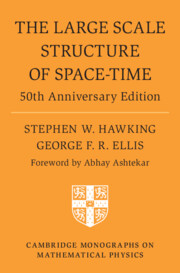Book contents
- Frontmatter
- Dedication
- Contents
- Foreword
- Preface to 50th Anniversary Edition
- Preface
- 1 The role of gravity
- 2 Differential geometry
- 3 General relativity
- 4 The physical significance of curvature
- 5 Exact solutions
- 6 Causal structure
- 7 The Cauchy problem in General Relativity
- 8 Space-time singularities
- 9 Gravitational collapse and black holes
- 10 The initial singularity in the universe
- Appendix A: Translation of an essay by Peter Simon Laplace
- Appendix B: Spherically symmetric solutions and Birkhoff’s theorem
- References
- Notation
- Index
3 - General relativity
Published online by Cambridge University Press: 17 February 2023
- Frontmatter
- Dedication
- Contents
- Foreword
- Preface to 50th Anniversary Edition
- Preface
- 1 The role of gravity
- 2 Differential geometry
- 3 General relativity
- 4 The physical significance of curvature
- 5 Exact solutions
- 6 Causal structure
- 7 The Cauchy problem in General Relativity
- 8 Space-time singularities
- 9 Gravitational collapse and black holes
- 10 The initial singularity in the universe
- Appendix A: Translation of an essay by Peter Simon Laplace
- Appendix B: Spherically symmetric solutions and Birkhoff’s theorem
- References
- Notation
- Index
Summary
Wepresent the theory as a number of postulates about a mathematical model for spacetime.
In §3.1 we introduce the mathematical model and in §3.2 the first two postulates, local causality and local energy conservation. These postulates are common to both special and general relativity, and thus may be regarded as tested by the many experiments that have been performed to check the former. In §3.3 we derive the equations of the matter fields and obtain the energy–momentum tensor from a Lagrangian.
The third postulate, the field equations, is given in §3.4. This is not so well established experimentally as the first two postulates, but we shall see that any alternative equations would seem to have one or more undesirable properties, or else require the existence of extra fields which have not yet been detected experimentally.
The mathematical model we shall use for spacetime, i.e. the collection of all events, is a pair (ℳ, g) where ℳ is a connected four-dimensional Hausdorff C∞ manifold and g is a Lorentz metric (i.e. a metric of signature + 2) on ℳ.
- Type
- Chapter
- Information
- The Large Scale Structure of Space-Time50th Anniversary Edition, pp. 56 - 77Publisher: Cambridge University PressPrint publication year: 2023

